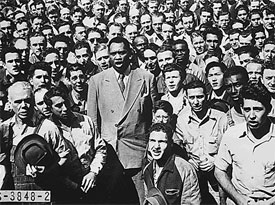
Paul Robeson leading shipyard workers in singing the “The Star Spangled Banner” in Oakland, California, 1942. ~ Photo courtesy of the National Archives (ARC Identifier 535874).
“Peat Bog Soldiers,” one of Europe’s best-known protest songs, reflects Robeson’s affinity for songs with a social meaning. Composed by political prisoners in a Nazi prison camp in the early 1930s, it became an anthem for the International Brigades during the Spanish Civil War, and continued to be sung for decades thereafter. During World War II it was both a marching song and a symbol of resistance to fascism. Since then it has been embraced by civil rights activists, anti-war protesters, and citizens demanding political change. The international flavor of the song, and its popularity in many languages, made it especially meaningful for Robeson.
As NMU seamen were close to Robeson’s heart, so were the international volunteers who risked their lives to fight for democracy against General Franco during the Spanish Civil War. Hundreds of seamen fought in Spain, some left directly from the picket lines of the Fall 1936 strike which paved the way for the NMU.
Far and wide as the eye can wander,
Heath and bog are everywhere.
Not a bird sings out to cheer us.
Oaks are standing gaunt and bare.
[Chorus]
We are the peat bog soldiers,
We are marching with our spades
To the bog.
Up and down the guards are marching,
No one, no one can get through.
Flight would mean a sure death facing,
Guns and barbed wire greet our view.
[Chorus]
But for us there is no complaining,
Winter will in time be past.
One day we shall cry, rejoicing.
Homeland, dear, you're mine at last.
[Chorus]